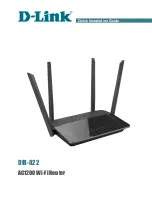
Chapter 5. Securing the Private
Network
You can secure your network by creating and applying rules that your router uses to
selectively block and allow inbound and outbound Internet traffic. You then specify
how and to whom the rules apply. To do so, you must define the following:
•
Services or traffic types (examples: web browsing, VoIP, other standard services
and also custom services that you define)
•
Direction for the traffic by specifying the source and destination of traffic; this is
done by specifying the “From Zone” (LAN/WAN/DMZ) and “To Zone”
(LAN/WAN/DMZ)
•
Schedules as to when the router should apply rules
•
Any Keywords (in a domain name or on a URL of a web page) that the router
should allow or block
•
Rules for allowing or blocking inbound and outbound Internet traffic for specified
services on specified schedules
•
MAC addresses of devices that should not access the internet
•
Port triggers that signal the router to allow or block access to specified services as
defined by port number
•
Reports and alerts that you want the router to send to you
You can, for example, establish restricted-access policies based on time-of-day, web
addresses, and web address keywords. You can block Internet access by applications
and services on the LAN, such as chat rooms or games. You can block just certain
groups of PCs on your network from being accessed by the WAN or public DMZ
network.
5.1 Firewall Rules
Advanced > Firewall Settings > Firewall Rules
Inbound (WAN to LAN/DMZ) rules restrict access to traffic entering your network,
selectively allowing only specific outside users to access specific local resources. By
default all access from the insecure WAN side are blocked from accessing the secure
LAN, except in response to requests from the LAN or DMZ. To allow outside devices
to access services on the secure LAN, you must create an inbound firewall rule for
each service.
If you want to allow incoming traffic, you must make the router’s WAN port IP
address known to the public. This is called “exposing your host.” How you make your
address known depends on how the WAN ports are configured; for this router you
Summary of Contents for DSR-1000N
Page 2: ...User Manual Unified Services Router D Link Corporation Copyright 2010 http www dlink com ...
Page 28: ...Unified Services Router User Manual 26 Figure 11 Manual WAN configuration ...
Page 60: ......
Page 90: ......
Page 102: ...Unified Services Router User Manual 100 Figure 64 SSL VPN Portal configuration ...
Page 123: ...Unified Services Router User Manual 121 Figure 82 Device Status display ...
Page 125: ...Unified Services Router User Manual 123 Figure 84 Resource Utilization statistics ...
Page 126: ...Unified Services Router User Manual 124 ...
Page 127: ...Unified Services Router User Manual 125 Figure 85 Resource Utilization data continued ...
Page 131: ...Unified Services Router User Manual 129 Figure 89 List of current Active Firewall Sessions ...
Page 140: ......
Page 144: ......
















































